Management Speak
Charting a path to sustainable growth
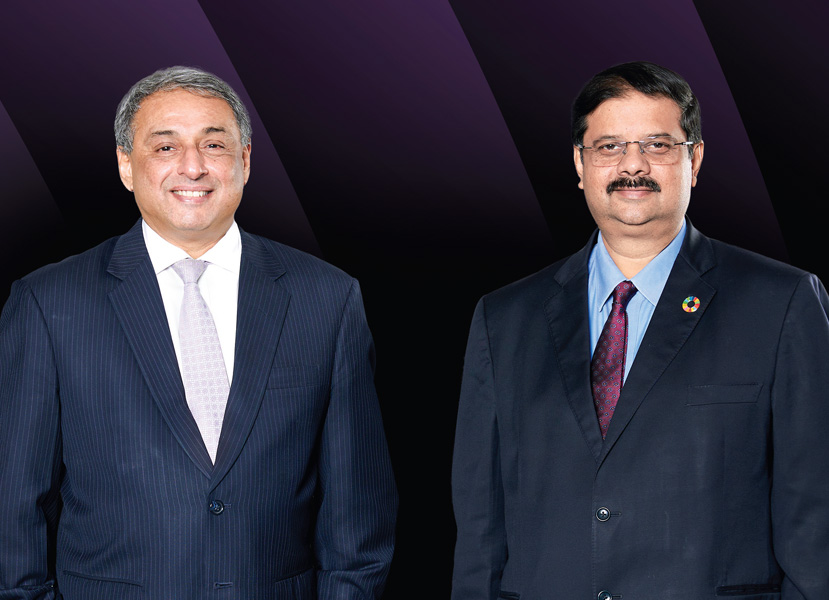
T. V.
Narendran
and Managing Director
Koushik
Chatterjee
Chief Financial Officer

Cold Rolling Mill, Tata Steel Kalinganagar
Q The year gone by was very volatile with considerable macroeconomic challenges. How did Tata Steel navigate these challenges?
The global economy including the steel industry faced significant volatility in 2022 due to multiple issues including the Russia-Ukraine conflict-induced global energy crisis, supply chain tightness and inflationary pressures, semiconductor shortage related issues, subsequent interest rate hikes by central banks globally, and moderated economic activity in China due to its zero-Covid policy. All these together impacted the steel demand-supply balance and resulted in significant contraction in steel price to raw material spreads through the year. Indian Steel makers were further impacted by the introduction of a 15% export duty from May 2022 till November 2022 which created supply imbalance compared to historical trends.
In Tata Steel, we responded with agility and sharpened our focus on managing the volatility by raising the bar on managing risks arising from sharp changes in underlying trading conditions especially given our long supply chain. This was demonstrated in our management of working capital where we ended the financial year with a release of over ~₹5,500 crore of in the fourth quarter. Our continuous improvement programs Shikhar in India and similar other initiatives in Netherlands and UK focussed on bettering operating metrices so that the adverse impact of contraction in price spreads could to some extent be mitigated. We also continued to focus on cash flow optimisation and prioritised our capital investments accordingly.
Q The performance of Tata Steel appears modest compared to the previous financial year 2021-22. Can you please provide a perspective on the performance in FY2022-23?
In Financial Year 2021-22 underlying market fundamentals were favourably aligned across the industry and the benefit of the same was reflected in Tata Steel’s financial performance also. However, by historical standards FY2021-22 can’t be considered as a trend year in the true sense. In fact, our Consolidated EBITDA for the year was ₹32,698 crore and the Profit After Tax was ₹8,075 crore. In FY2022-23, Tata Steel on a consolidated basis reported its 2nd highest ever EBITDA.
During the year, Tata Steel India’s operational performance witnessed many firsts and records including highest-ever crude steel production of 19.9 million tons, growing 4% on a Y-o-Y basis. India deliveries increased in line with production, surpassing the previous record. The Automotive sector saw a 5% Y-o-Y increase, Branded Products and Retail rose by 11% Y-o-Y, and Industrial products & projects were up by 14% Y-o-Y. The EBITDA for Tata Steel India stood at ₹27,561 crore, translating to an EBITDA per ton of ₹14,606, which is the third highest in the history of the Company and reflects the resilience of the India business inspite of a very volatile and challenging external environment. The Company's India crude steel production now accounts for two-thirds of its overall production and this trend is expected to continue as we focus on investments and growth in our home market where we enjoy a premium leadership position.
In our European business, Tata Steel recorded a revenue of £9,293 million and EBITDA was £477 million resulting in EBITDA per tonne of £58. The sharp reduction in steel prices in the second half of the year, high energy costs due to the conflict in Ukraine and above normal inflation impacted the financial performance for the year. The ongoing upgrade of Tata Steel Nederlands' Cold Mill in IJmuiden Plant had an adverse impact on the product mix as well.
During FY2022-23, we also undertook key strategic initiatives towards growth and long term value creation. In the first half of the year, Tata Steel Long Products Limited, completed the acquisition of Neelachal Ispat Nigam Limited (NINL) under the Government of India divestment program, at an aggregate consideration of approximately ₹12,100 crore. This acquisition is part of the master plan for our long products business and being part of the Kalinganar eco-system is well positioned to grow synergistically in the future. The acquisition was efficiently implemented and even though the NINL plant had been mothballed for nearly three years, within just nine months of this acquisition, we successfully ramped up the production run-rate to its rated capacity of ~1 million tonnes on an annualised basis.
Secondly, as part of our organic growth strategy, towards the end of the financial year, we commissioned the first circuit of the 6 MnTPA Pellet Plant and the Pickling Line and Tandem Cold Mill Line within the 2.2 MnTPA Cold Rolling Mill complex at our Kalinganagar plant.
As part of our strategy to invest in circularity and deploy capital towards low carbon steel making, Tata Steel also signed a Memorandum of Understanding (MoU) with the Government of Punjab to establish a state-of-the-art scrap utilising electric arc furnace (EAF) based long products steel plant in Ludhiana, with a capacity of 0.75 MnTPA. The plant is expected to be operational within two years and will produce construction-grade steel rebar under brand 'Tata Tiscon’.
Considering the year’s financial performance and based on the overall review of the business, the Board of Directors recommended a dividend of ₹3.60 per equity share of face value ₹1/- each.
Q The net debt of Tata Steel increased compared to FY2022-23, will the Company go back to the deleveraging journey?
On a steady state basis our deleveraging journey will continue and is an enterprise strategy which we remain committed to. To put this in perspective, in FY2022-23 we undertook the acquisition of NINL with outflow of ~₹10,000 crore and also the acquisition of a ferro alloys processing unit for ~₹1,000 crore during the year. In addition, we allocated sizeable capex on the ongoing 5 MnTPA brownfield expansion in Kalinganagar. Therefore, the capital allocation on growth was higher to help provide a step change in earnings and cash flows for the future. Apart from this, the year witnessed a significant contraction in steel price to raw material price spreads, as well as high levels of energy costs, which had an adverse impact on earnings and cash flow generation. We are committed to cash flow optimisation and in the last quarter of the financial year 2022-23, we were able to reduce debt by around ₹3,700 crore on the back of a special drive on working capital management.
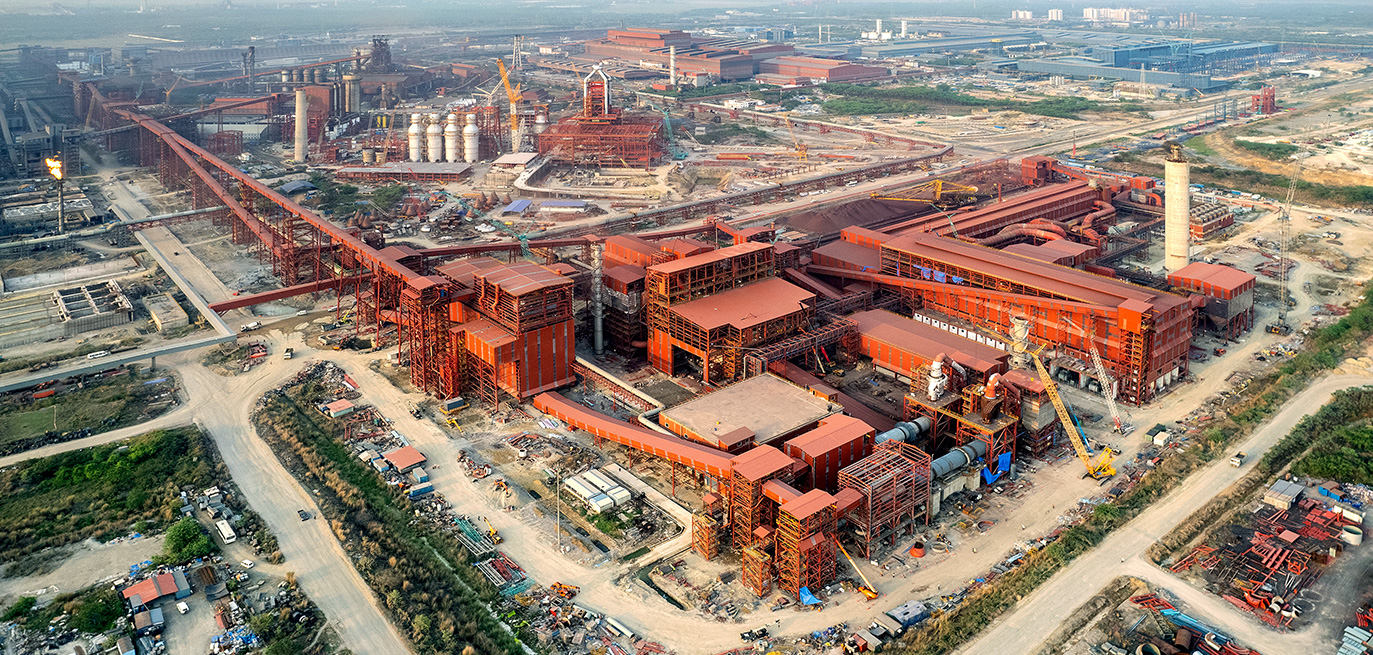
Pellet Plant, Tata Steel Kalinganagar
Q Can you share the Company's projected capital expenditure for FY2023-24?
The projected capital expenditure
(capex) for FY2023-24 is set at
₹16,000 crore on a consolidated basis
which is intended to be financed
through internal accruals over the full
year. Of this, ₹10,000 crore is towards
Tata Steel Standalone operations of
which the Kalinganagar project will
account for approximately 70%. Our
other Indian subsidiaries, currently in an
expansion phase with value accretive
projects, especially in downstream
operations which are important to
service customer needs and improve
our value-added product mix, will
have a capex of about ₹2,000 crore. In
Europe, Tata Steel Nederland will incur
capex of ₹1,100 crore on the relining
of its blast furnace, which is underway.
The remainder of the capex is largely
allocated towards and will be spent on
sustenance, environmental initiatives,
and improvement projects.
Q The Board approved the amalgamation of seven subsidiaries and an associate company into Tata Steel. How does this move align with the Company's broader strategy and what is the expected timeline for its completion?
The proposed amalgamations are expected to enhance management efficiency, drive sharper strategic focus, and improve agility across businesses. They will also drive synergies through raw material security, centralised procurement, optimisation of inventories, reduced logistics costs, and better facility utilisation. Furthermore, it is expected to enable growth in value-added segments and reduce overhead and corporate costs.
Each of the amalgamations are expected to create value for all shareholders and also aligns with Tata Steel's long-term strategy to simplify the group holding structure.
The proposed amalgamations are currently going through judicial and regulatory process. We expect the process to complete by the end of this financial year.
Q Given the UK upstream and midstream assets are reaching end-of-life in the next 12 to 24 months, what is the strategy in relation to the future of the business outside of the discussions with the UK Government for transitioning to low carbon configuration?
Tata Steel has had active and detailed discussions with the UK Government in relation to the future of the UK business. Given the UK’s decarbonisation journey and rising carbon costs, it has been clear that for the continuity of steel making in the long-term, it is necessary for Port Talbot to transition to alternative green technologies. Tata Steel has therefore sought support from the government in two forms: (a) In policy terms by encouraging the transition to green steel and ensuring a cost competitive landscape, and (b) partnership in financing of the project given the size of investment and the financially constrained position of our UK business. These discussions are ongoing.
At the same time, some of the existing heavy end assets in Tata Steel UK will reach end of useful life over the following few years. The management of Tata Steel UK will evaluate all scenarios with regard to the future configuration of the business and will consult appropriately with various stakeholders prior to relevant strategic decisions being taken. Any decision making will also take into account our market, customers, supply chain impacts and safe operating practices for our employees.
Q How is Tata Steel furthering its commitment to decarbonisation and sustainable operations?
Tata Steel is committed to the Tata Group’s stated objective of achieving Net Zero emissions by 2045, as part of the group-wide Project Aalingana (embrace). Under this project the Tata Group is focused not just on the decarbonisation of businesses and value chains; but also applying a systemic, circular economy approach to reduce resource use and waste; and preserving and restoring the natural environment.
Tata Steel’s approach and pace of decarbonisation will be calibrated for each location based on the local regulatory framework, government support, and the willingness of customers to pay for higher-cost green steel.
The IJmuiden steelworks of Tata Steel Nederland already rank 3rd in the 2022 CO2 intensity benchmark for Blast Furnace based steel producers, published by the World Steel Association. Even so, Tata Steel Nederland has a public commitment to reduce its CO2 emissions by 5 Megatons by 2030. In July 2022, it entered an Expression of Principles with the Ministry of Infrastructure and Water Management, and the Ministry of Economic Affairs and Climate in the Netherlands. It is committed to transitioning in a phased manner out of blast furnace operations to steel making using Direct Reduced Iron technology and electric smelting, with an eventual transition to Green Hydrogen depending on availability and economics. It is currently engaged with multiple technology and engineering partners to complete detailed evaluation and engineering, implementation planning and costing of the project.
Tata Steel Nederland is also undertaking a comprehensive project to reduce dust and other fugitive emissions from its plant to make it future ready. It has committed to spend €300mn in Roadmap+ investments, including an ongoing de-NOx investment in the pellet plant (largest environment installation in a pellet plant in the world), covering bunkers and transport systems and installing dust screens, and upgraded coal filters. These projects are currently under implementation and part of the planned capital expenditure in the Company.
In Europe, we have also already launched low carbon steel products. Zeremis® Carbon Lite, launched in Tata Steel Nederland, is a steel with an allocated carbon footprint reduction of up to 100%. Several customers including Wuppermann, BILSTEIN, EMW Stahl Service, Arania, Permastore and Hardt Hyperloop have reached agreements to source this steel. In fact, underlining the demand for green steel in Europe, Tata Steel Nederland has already signed a memorandum of understanding with Ford to supply the carmaker with Zeremis green steel once the IJmuiden steelworks switches to green hydrogen-based steelmaking. We offer similar Carbon Lite solution from our UK operations under the brand name Optemis™ Carbon Lite.
In our India Steel operations, we
adopt a two-pronged approach to
decarbonisation, focussing on Carbon Direct Avoidance (CDA) and CO2 Capture
and Use. We have implemented several
initiatives as test and incremental
cases including conducting a trial of
continuous Coal Bed Methane (CBM)
injection, hydrogen injection in blast
furnaces, operating a carbon capture
and utilisation plant at pilot scale, and
increasing scrap charge in our blast
furnaces. As stated earlier, we are
working to establish a
state-of-the-art
scrap utilising electric arc furnace
(EAF) based long products steel plant
in Ludhiana, with a minimal carbon
footprint and a capacity of 0.75 MnTPA.
Tata Steel in India is also deeply committed to reducing freshwater consumption, developing sustainable supply chains, and embracing circular economy principles. We are maximising effluent treatment and increasing the usage of treated water from sewage treatment plants in Jamshedpur and through storm water recovery at Kalinganagar. Tata Steel is also looking to both maximise the usage of scrap in our existing blast furnace based operations (in addition to setting up electric arc based facilities) as well as maximising solid waste utilisation within our own operations and through the sale of by-products. We have launched Tata Aggreto and Tata Nirman, India’s 1st branded steel slag products. Furthermore, we remain dedicated to the United Nations Sustainable Development Goals (SDGs) with a particular focus on greenhouse gas (GHG) emissions, specific fresh-water consumption, and circular economy targets. We are also committed to enriching our portfolio of green products.
We are happy to share that in recognition of our efforts, Tata Steel has been recognised by worldsteel as a Sustainability Champion for the sixth consecutive time.
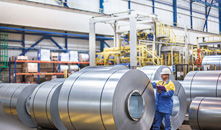
In Europe, we have launched Zeremis® Carbon Lite and Optemis™ Carbon Lite, low carbon steel products, having allocated carbon footprint reduction of up to 100%.
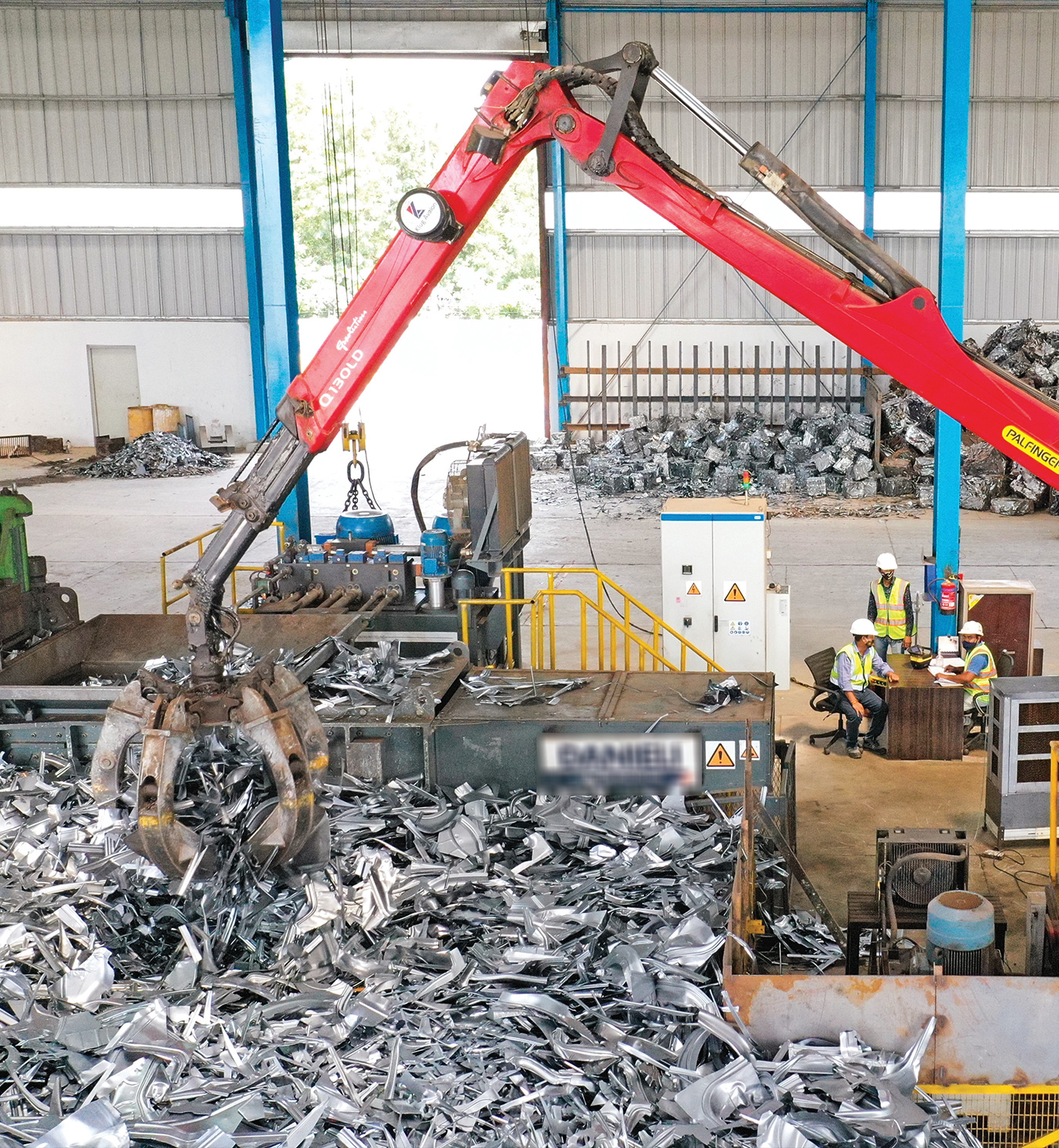
Steel Recycling Plant, Rohtak, Haryana
Q Can you shed light on the economics and timelines of the green hydrogen project, focusing on the pilot injection directly into the blast furnace in India?
In India, Tata Steel has embarked on a ground-breaking experiment that is still in its early stages. The Company initiated a trial, the first-of-its-kind globally, at its Jamshedpur Works, injecting a record-high quantity of hydrogen gas directly into one of its Blast Furnaces.
This trial provided us with valuable data and information, helping us plan for the next level of scale. Our goal is to determine how much of the Pulverised Coal Injection (PCI) can be substituted with hydrogen. Encouragingly, we have observed that injecting hydrogen yields a net benefit, reducing the coke rates by about 10% to 15%. We are carefully evaluating the implications of any change on the overall process, particularly regarding the energy balance and the constituents within a blast furnace.
The significance of the trial lies in its contribution to the steel industry's journey towards green and sustainable steelmaking. By injecting hydrogen gas into the blast furnace, Tata Steel aims to reduce fossil fuel consumption and consequently lower CO2 emissions from the steelmaking process. The eventual adoption of this technology at scale and its wide implementation will be dependent on how quickly the cost of hydrogen reduces to more competitive levels.
Q As the global reporting landscape shifts towards sustainability reporting, what actions is Tata Steel taking towards fulfilling this requirement?
Tata Steel has historically taken a leadership position in transparently and comprehensively reporting on its performance in relation to ESG (Environmental, Social, and Governance) parameters. In 2015-16, Tata Steel transitioned from compliance-based to governance-based reporting and published the country’s 1st Integrated Report despite there being no statutory mandate and has continued on this journey of improvement of its disclosure standards each year. We believe that a sustainable finance framework, effective and transparent reporting, and comprehensive disclosures will not only aid our investors and stakeholders, but also help us to accelerate the transition to a more sustainable long-term future.
We are actively involved in aiding the growth of national and global disclosure standards and their subsequent adoption. We are active within the IFRS Foundation which is responsible for the development of disclosure standards through the International Accounting Standards Board (IASB) and International Sustainability Standards Board (ISSB). Tata Steel has adopted the recommendations of the Taskforce on Climate-related Financial Disclosures (TCFD), has undertaken independent assessment of its Physical and Transition Climate risks and published a Climate Change Report on a consolidated basis, aligned with the recommendations of TCFD, as part of Tata Steel’s Integrated Report for FY2022-23. We have taken the lead in the Indian Steel Industry for environmental certification of our products and published GreenPro certification for Steel Rebars (Tata Tiscon), Tubes (Tata Structura, Tata Pipes, Tata EzyFit), Steel Doors and Windows (Tata Pravesh) and Ground Granulated Blast Furnace Slag (Tata Aggreto). Tata Steel in Europe is also the first steel manufacturer to become an approved Environmental Product Declaration programme operator in Europe. Tata Steel also conducts Life Cycle Assessment for a range of products across multiple geographies, which aligns with Tata Steel's commitment to be a benchmark in sustainability disclosures and to provide customers with productspecific sustainability information.
We have also released our first Business Responsibility and Sustainability Report (BRSR) this year, on a consolidated basis, providing an in-depth analysis of our corporate social responsibility and sustainability initiatives, and an insightful overview of our efforts during the past year. We have also undertaken assurance for key ESG indicators for all major Tata Steel Group entities in India and Europe for the first time.
Q What actions were taken in the area of Research & Development by Tata Steel during the past year?
During the year, we set up a Centre for Innovation in Mobility at the Indian Institute of Technology (IIT) Madras Research Park focused on developing futuristic application technologies in automotive, railways, and hyperloop. We signed a Memorandum of Agreement with TuTr Hyperloop which aims at collaborating to develop and deploy Hyperloop technology at scale. We established a Centre for Innovation in Mining and Mineral Beneficiation at the Indian Institute of Technology (Indian School of Mines), Dhanbad. We are working with BHP to study low carbon, iron and steelmaking technologies. The partnership with Aarav Unmanned Systems (AUS), a Bengaluru-based drone solutions startup, aims to improve the efficiency, safety, and productivity of open-cast mining operations. We are also working with C-MET Thrissur, an autonomous society of MeitY, Government of India, and Digital University Kerala, to pioneer groundbreaking graphene technologies. Our New Materials Business (NMB) intends to swiftly translate research ideas into market-ready products through collaboration with a diverse community of scientists, researchers, start-ups, and industrial organisations.
In Europe we have developed a material database, Aurora Online that has been recognised by our automotive OEMs for data accuracy and has applications in computer simulations to avoid surprises while forming parts and/ or crash testing. The business is working on novel paint curing technologies, bio-based or inorganic insulation materials as well as recycling options for existing PIR (Poly Iso Cyanurate) based composite panels. Our European and India businesses are collaborating on development of high-strength coated steels and new primary coating like MagiZinc®, use of digital, AI and solar and alternative energy technologies.
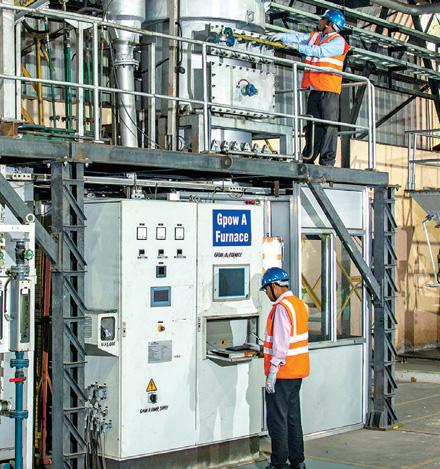
Graphene facility, Tata Steel Jamshedpur
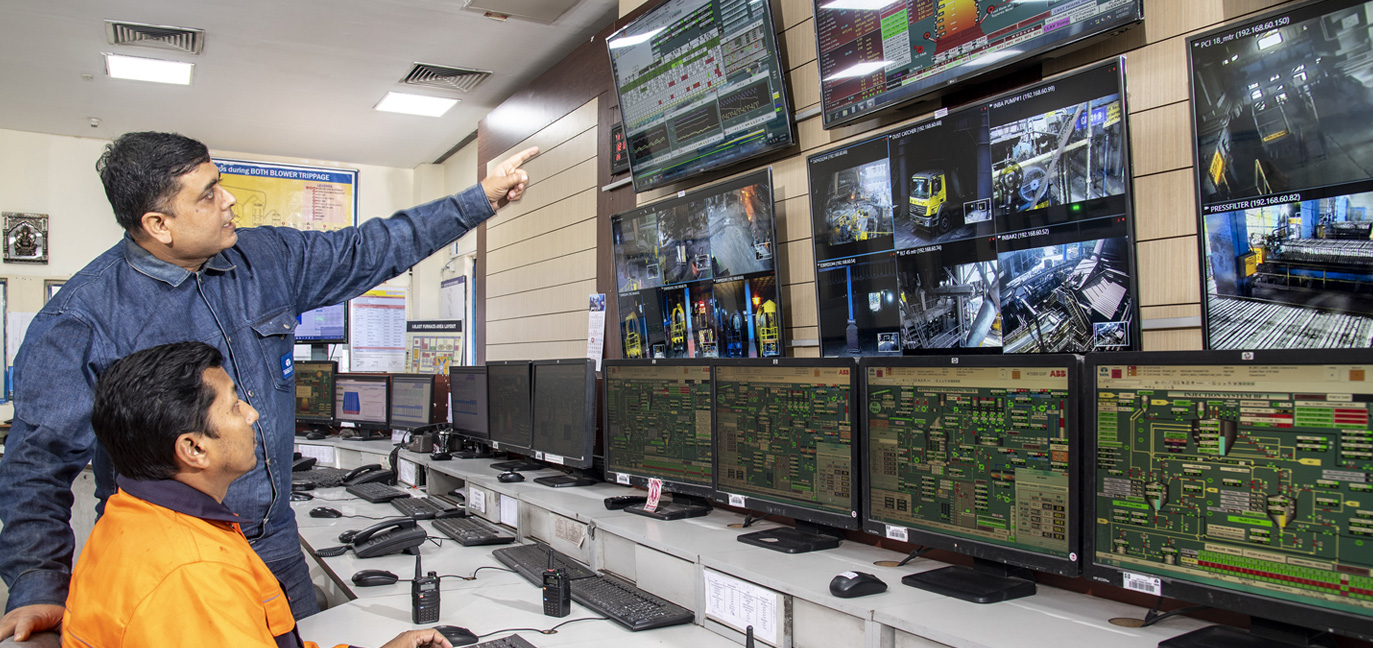
Fostering learning and development
Q The Company asserts the employees to be its most valuable assets. What are the strategic measures the organisation has introduced to support employee development?
We adhere to a “People First” philosophy. Our focus is on nurturing our workforce, fostering a conducive environment that inspires our employees to realise their full potential and maintaining a high level of engagement.
In the past year, we initiated agile behavioural assessments and employee referral programs to leverage internal talent and strengthen our cultural ethos. Our internal talent marketplace, 'Step Up', offers employees with projects and mentoring opportunities matching their experience and aspirations, thereby fostering a dynamic, skills-focussed ecosystem. We have introduced “Virtual Reality” and simulation-based training to enhance experiential learning. We added 16 new Schools of Excellence (SoEs) in various areas including Mining, Engineering & Projects, Operations, and Digital domains.
To ensure high quality learning experiences, we partnered with reputed content providers and introduced new learning platforms, enriching the upskilling journey for our employees. Our Industry-leading policies and concerted efforts earned us the “Great Place to Work” certification by the Great Place to Work® Institute for the sixth consecutive year. Our pioneering role in fostering an inclusive workplace that values human capital was recognised with the “GOLD” award for the second consecutive year by the India Workplace Equality Index (IWEI), 2022 and acknowledgement by the World Economic Forum as a Global Diversity, Equity & Inclusion Lighthouse.
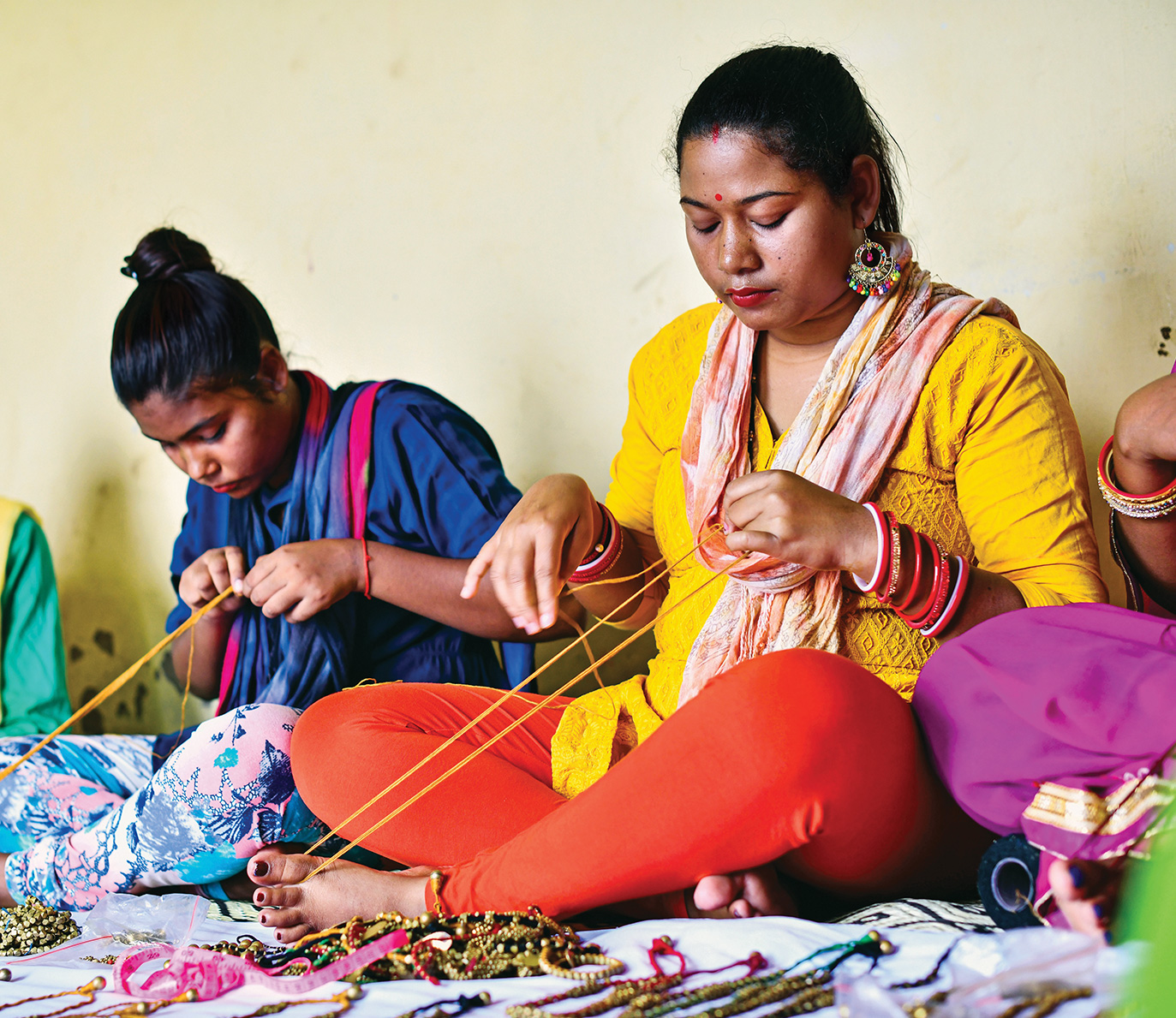
Care for community
Q How do the CSR initiatives and outreach activities contribute to the growth and empowerment of the communities where we operate?
The communities we operate in, are an integral stakeholder as well as critical to ensuring the sustainability of our operations. Our aim is to create significant social impact and contribute to their growth and development through our CSR initiatives and outreach programmes.
We seek to actualise national change models that effectively address the country’s core development objectives. By partnering with communities, we focus on environmental sustainability, health and well-being, education and learning. By fostering change-makers within communities, we empower them to shape their progress and bring about transformative societal change.
Our CSR initiatives in India, encompass healthcare, safe drinking water, livelihood generation, education and sports, environmental conservation, preservation of tribal art and culture, and community development. We engage with government authorities, NGOs to designing effective programmes that are aligned with community aspirations. We measure the impact of our programmes through periodic impact assessments and evaluations. We also encourage feedback from stakeholders to continuously improve our programmes and maintain transparency.
In FY2022-23, we expanded our focus areas to address post-COVID realities, promote climate convergence, enhance entitlements, and raise awareness among businesses. We scaled up our existing signature and proximate impact programs, strengthening our relationship with communities. We reached over 3.15 million lives in FY2022-23 which was the highest ever, and saw new focus areas emerge in addition to our established efforts - (a) we understood the most enduring post-pandemic deficits amongst communities and designed solutions - foundational learning programmes addressing learning gaps for 2,00,000+ children in primary schools, non communicable disease screening programmes which promoted health seeking behaviour and setting up permanent market places like Johar Haat for marginalised artisans who otherwise do jot have access to markets; (b) we designed community embedded responses to climate change through conservation programmes for 4 species, (c) we enhanced capabilities for more than 25,000 individuals to access their entitlements and (d) created social immersion experience for more than 550 business students and managers to lay a strong foundation for responsible business leadership. Our efforts were recognised by the Government of India, Ministry of Corporate Affairs, with the National Award for Excellence in CSR and the National Award for Contribution in Education.
In the case of Tata Steel Nederland, our work with communities focuses on the region of Tata Steel in IJmuiden (IJmond region). The engagement with the communities focuses on reducing the environmental impact on our direct surrounding and neighbours, ensuring dialogue and communications with key communities and strengthening relations with them. As stated earlier, the Roadmap + programme includes an extensive set of investments in various installations at IJmuiden that should bring about a significant reduction in emissions, dust, odour and noise. In order to engage with the community, Tata Steel Nederland publishes an annual printed report on progress of measures, a quarterly online and printed dashboard showing the progress of measures, including current affairs and trend in complaints, live events, interactive panel discussions, walk-in hours at the community information desk, site visits and internal awareness programmes amongst others. To ensure strong relations and extensive interactions with the community, we have had meetings of senior Tata Steel Nederland management with local government leaders, regional ministers, and local representatives of the Wijk aan Zee community in the ‘Dorpsraad’ (Village Council) and with representatives of local neighbourhood councils from the IJmond region gathered in the ‘Burentafel’ (‘Neighbour table’). A monthly survey is held amongst inhabitants of Wijk aan Zee community to measure sentiment, primarily around hindrance issues. A quarterly printed newspaper, is delivered door-to door to inhabitants in the region and includes latest news and information on Tata Steel Nederland, highlights local events and includes updates of the environmental measures from the Roadmap+ programme.

Sports is a way of life at Tata Steel